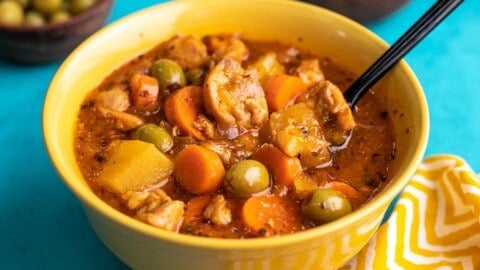A flavorful deep dive into pollo guisado — the beloved stewed chicken dish. Learn its history, ingredients, cooking tips, and secrets to making it unforgettable, straight from an expert food enthusiast.
Pollo guisado is one of those dishes that warms both the stomach and the soul. Known in many Latin American and Caribbean kitchens, it’s a stewed chicken recipe that feels like a culinary hug. The name may sound simple, but the flavors are anything but. This dish embodies layers of taste built through slow cooking, seasoned with love, and served with pride.
Whether you first tried pollo guisado in your grandmother’s kitchen, at a bustling street market, or in a cozy neighborhood restaurant, you probably remember the richness of the sauce, the tenderness of the chicken, and the way every bite told a story. In this article, we’re going to explore every aspect of pollo guisado — from its cultural roots and ingredient variations to cooking techniques and serving tips.
Understanding the Essence of Pollo Guisado
To truly appreciate pollo guisado, you need to understand that it’s more than just stewed chicken. The term itself translates to “stewed chicken” in Spanish, but the simplicity of the name hides a dish that’s deeply complex in flavor. The slow-cooking process allows the spices, herbs, and vegetables to meld with the chicken, creating a rich, savory sauce that clings to every bite.
In different countries, pollo guisado takes on unique characteristics. In Puerto Rico, you might find olives and capers adding a briny touch. In the Dominican Republic, you may get potatoes and carrots for heartiness. In Colombia, achiote or saffron might give it a warm, golden color. Despite these variations, the heart of pollo guisado remains the same — a comforting, home-style stew that brings people together.
The Cultural Significance of Pollo Guisado
Pollo guisado is a staple in many Latin homes because it’s the perfect combination of budget-friendly and deeply satisfying. The dish uses accessible ingredients but transforms them into something extraordinary. It’s the kind of meal that can feed a large family without breaking the bank, yet still feels special enough for a celebration.
In many cultures, sharing a pot of pollo guisado means more than just eating together. It’s about slowing down, savoring flavors, and connecting with one another. The preparation often starts in the morning, with family members chopping vegetables, seasoning the chicken, and letting it marinate. By lunchtime or dinner, the kitchen is filled with the irresistible aroma of simmering sauce — a scent that can pull everyone to the table without a word being spoken.
Key Ingredients That Define Pollo Guisado
While recipes vary from household to household, there are certain ingredients that define pollo guisado. Fresh chicken pieces form the foundation, typically bone-in for extra flavor. Garlic, onions, and peppers are the aromatic base that builds the stew’s depth. Tomatoes, tomato paste, or sofrito add a tangy-sweet richness, while herbs like cilantro or parsley bring freshness.
The seasoning mix is crucial. A well-made pollo guisado often includes oregano, cumin, and sometimes paprika or annatto for color. Salt and pepper are essentials, but the real magic comes from the balance — not letting any one spice overpower the others. Some cooks add a splash of vinegar or citrus juice for brightness, cutting through the richness of the stew.
Ingredient Overview Table
| Ingredient | Role in the Dish |
|---|---|
| Chicken (bone-in) | Main protein, adds depth of flavor during slow cooking |
| Garlic & Onion | Aromatic base for savory flavor |
| Bell Peppers | Sweetness and mild bite |
| Tomatoes/Sofrito | Richness and tang, deepens the sauce |
| Herbs & Spices | Flavor complexity, cultural variation |
| Potatoes/Carrots | Hearty texture, makes the stew more filling |
| Citrus/Vinegar | Brightness and balance |
The Role of Sofrito in Pollo Guisado
If pollo guisado has a secret weapon, it’s sofrito. This aromatic blend of herbs, vegetables, and spices is the heart of many Latin dishes. In its most common form, sofrito includes garlic, onions, peppers, cilantro, and culantro, blended or finely chopped to create a flavor base that perfumes the entire stew.
Sofrito is sautéed in oil before the chicken is added, unlocking deep, rich aromas. It’s this step that transforms simple ingredients into a sauce that’s layered with complexity. While you can buy pre-made sofrito, making it fresh allows you to control the flavor balance and adjust it to your taste.
Cooking Techniques for the Perfect Pollo Guisado
The magic of pollo guisado comes from slow, steady cooking. After seasoning the chicken, it’s often browned first to seal in juices and add a deeper flavor. Then, the aromatics and vegetables are sautéed, followed by the addition of liquid — usually chicken stock, water, or a mix with tomato sauce.
Simmering is key. The dish is cooked gently until the chicken is fall-off-the-bone tender and the sauce has thickened to a luscious consistency. Stirring occasionally ensures that nothing sticks to the bottom of the pot and that flavors are evenly distributed. Patience is rewarded with a sauce that clings perfectly to the chicken and vegetables.
Variations Across Latin America and the Caribbean
In Puerto Rico, pollo guisado often includes green olives, capers, and potatoes, creating a briny, hearty stew. The Dominican version leans toward a tomato-rich base with plenty of fresh herbs. In Cuba, you might find it paired with rice and fried plantains for a sweet-salty contrast.
Colombian pollo guisado sometimes features achiote oil, which gives the dish a bright golden color and a slightly earthy flavor. In Mexico, you might encounter versions with smoky chipotle or guajillo chiles, adding a warm heat to the dish. Each region has adapted the recipe to its local produce and flavor preferences, yet they all preserve the soulful heart of pollo guisado.
Serving Suggestions for Pollo Guisado

Pollo guisado is wonderfully versatile when it comes to serving. Traditionally, it’s paired with white rice, which soaks up the sauce perfectly. Fried plantains or tostones make an excellent side, adding a crispy texture to contrast the tender chicken.
Some prefer to serve it with boiled yuca, mashed plantains, or even a fresh salad for a lighter touch. A slice of crusty bread can also work beautifully, letting you mop up every last drop of sauce. The important thing is to balance the richness of the stew with sides that complement — not compete with — its flavors.
Expert Tips for Making Pollo Guisado at Home
If you want your pollo guisado to taste like it came from a seasoned cook’s kitchen, start by marinating the chicken ahead of time. Even an hour makes a difference, letting the spices penetrate the meat.
Don’t rush the browning process — this step adds a deep, roasted flavor that enriches the entire dish. Taste the sauce as it simmers, adjusting seasoning along the way. And if you want a thicker sauce, remove the lid toward the end of cooking to let some of the liquid reduce naturally.
Common Mistakes to Avoid When Cooking Pollo Guisado
One of the biggest mistakes is overcooking the vegetables before adding the chicken. You want them tender but not mushy, so they hold their texture in the finished dish.
Another pitfall is adding too much liquid at once. Remember, you can always add more broth if needed, but it’s harder to fix a watery sauce. Finally, resist the urge to turn up the heat to speed things along — pollo guisado rewards patience with a depth of flavor you simply can’t rush.
Quotes from Home Cooks and Chefs
“Pollo guisado is the dish I make when I want to remind my family of home. The smell alone takes me back to my childhood kitchen.” — Mariela, Home Cook
“The secret is in the sofrito. Get that right, and everything else falls into place.” — Chef Roberto Sánchez
FAQs about Pollo Guisado
What does pollo guisado taste like?
It’s savory, rich, and aromatic, with a balance of sweetness from vegetables, tang from tomatoes or citrus, and depth from slow-cooked chicken and spices.
Can I make pollo guisado ahead of time?
Yes, it often tastes even better the next day as the flavors meld. Store it in the fridge and reheat gently.
Is pollo guisado spicy?
Traditionally, it’s not very spicy, but you can add heat with fresh chilies or hot sauce if you like.
Can I use boneless chicken?
You can, but bone-in chicken delivers a deeper, more authentic flavor.
What’s the best side for pollo guisado?
White rice is classic, but plantains, yuca, or bread are also great choices.
Conclusion
Pollo guisado is more than just a recipe — it’s a tradition, a comfort, and a celebration of simple ingredients transformed through care and patience. Whether you stick to your family’s version or experiment with new flavors, this dish will always have the power to bring people together around the table.




